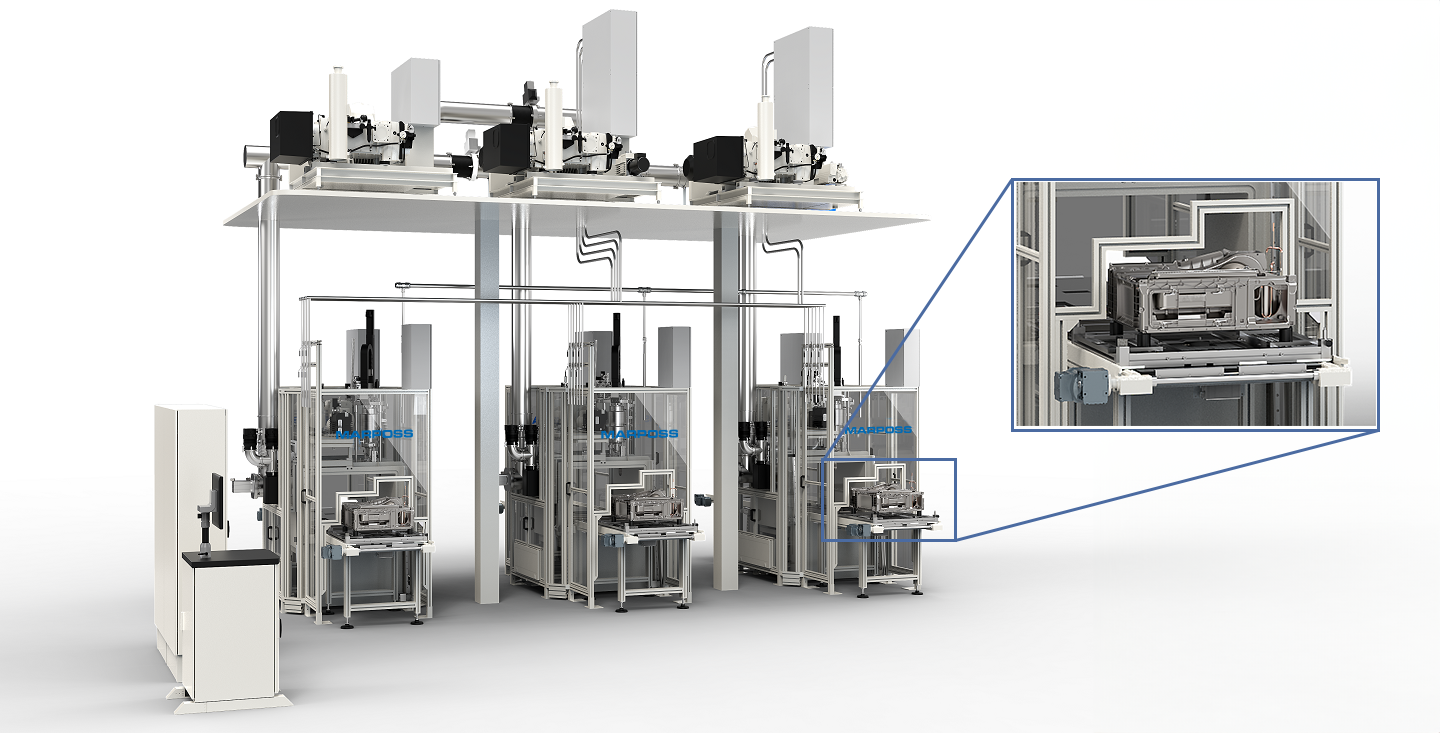In-Line Leak testing: Advanced industrial solution for Appliances

Together with Marposs towards the improvement of HVAC energy efficiency
In the context of the White Goods/Home Appliances industry, the Marposs Dryer Heat Pump Leak Test application is a high-tech end-of-line test that allows the manufacturer to guarantee very high quality in its final product, without sacrificing the high productivity it must maintain to meet market demand with actual production sites.
With this solution, the hard vacuum helium leak detection system applied to the entire finished assembly provides the most reliable method of detecting global leakage on the circuits.
In the testing method, the tracer gas is Helium 100% and the analysis system is the mass spectrometer measurement in a vacuum chamber; this method is the most powerful among the various leak testing systems, aiming at the detection of the smallest quantity of leak, values.
Marposs in-line leak test machines are able to test the heat pump assembly with a leak threshold in the range of 10-5 mbar*l/s. For a better evaluation, compare this with a traditional nitrogen leak test in a water tank, which gives results estimated in the range of 10-2 mbar*l/s (one bubble with a radius of 2 mm in 1 second), but taking into account the totally human guesswork and then including undetected bubbles/leaks.
The critical issue for automatic testing is clearly represented by the large manufacturing tolerance in all directions for the coolant tubes. To overcome this, a very flexible coupling design has been developed by Marposs which allows the inlet pipe to be connected automatically, despite the high uncertainty of positioning in the assembly. The coupler has a large compensating capacity, even when a large distance is covered up and down to reach the connection point with vertical pneumatic movement.
A highly applicable manual test has been realized as a fully automatic test, with enormous benefits for production.
The modular solution (from 1 to several leak test stations) offers a wide range of productivity in fully automated production.
Leak testing is a fundamental operation in all thermal exchange processes using refrigerant gases to ensure the long-term tightness of refrigerant-containing components and to guarantee performance in terms of heat exchange efficiency.
The increasing demand for energy-efficient heat exchange systems is one of the main drivers for high-accuracy leak testing of HVAC products.
In the context of climate control and, ultimately, the increased attention being paid to the potential contribution of refrigerant compounds to global warming, only leak-testing solutions that enable this will be more reliable and accurate.
In addition, to ensure accuracy, a leak test solution must be used and all parts and circuit connections must be guaranteed to comply with a total leakage lower than that permitted by law (specific thresholds for each chemical compound). That’s why not only the components but also the final assembly must undergo this EOL leak test.
In order to achieve the efficiency of the thermal assembly in its final installation, leak detection provides important confirmation that the heat exchange efficiency will not degrade over a reasonable warranty period until the use and consumption of the parts becomes relevant.
Marposs Solutions is strongly focused on developing the best leak-testing performance for more efficient products.
The hard vacuum test chamber method also provides some additional tests that complete and add value to the test station.
A basic test is the standard preliminary gross leak test carried out on the dryer heat pump assembly using the air pressure decay technique so that in the event of a major defect on a part, valuable advantages are achieved by eliminating the fine leak test on NG parts and thus saving time, as well as providing quality data management for production process adjustment.
The second basic test available is the manual sniffing system always fitted to Marposs HLT vacuum machines to enable maintenance, troubleshooting, and re-positioning of leaks for corrective action in the production process.
Other cases are additional functional tests for electro-pneumatic devices in the unit, which can be performed in the same test station. All under full test traceability specifically designed for manufacturer-to-end user warranty purposes.
Marposs can provide the helium recovery system with a high efficiency (85-95%). The system is connected to the leak test machines, recovering the helium used for each test cycle and recycling it to feed the leak test machines again in a closed system.

Helium purity is analysed and, if necessary, corrected by refilling and final compression of the stored helium to the required test pressure. The recovery output provides leak test set points to the HLT machines so that data outside the acceptable range generates alarms to avoid false leak detection. The fully integrated process gives better accuracy and reliability to the system, with the shortest return on investment as ever.





